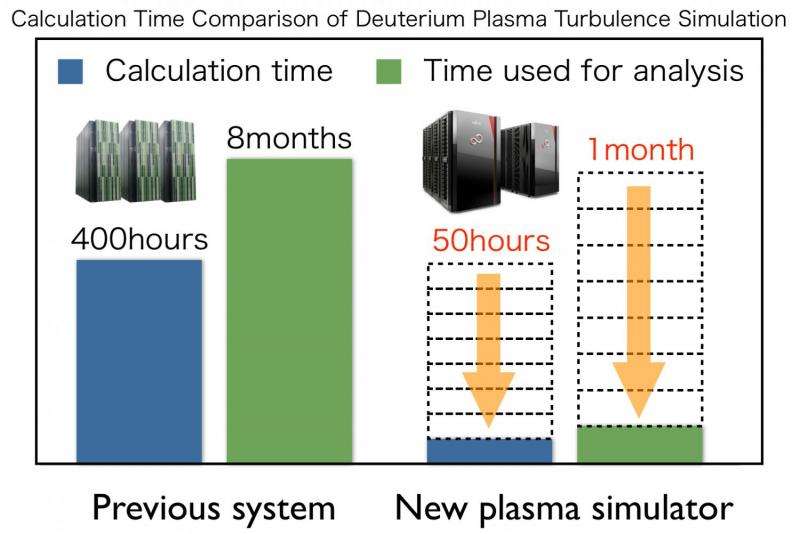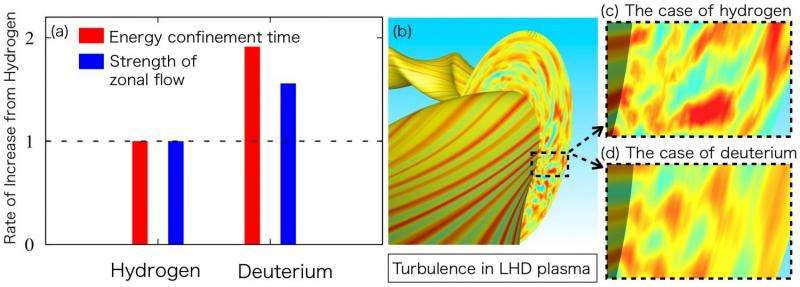Accelerating fusion research through the cutting edge supercomputer

At the Inter-University Research Institute Corporation National Institutes of Natural Sciences National Institute for Fusion Science, for the first time in the world, using the newly installed "Plasma Simulator" we have simulated deuterium plasma turbulence in the Large Helical Device (LHD). From this result, we have clarified that the energy confinement in a deuterium plasma is improved in comparison to a hydrogen plasma. The performance of the plasma simulator, which is a specialized computer utilized for plasma and fusion science research, is the best in the world. These results obtained from complete use of the performance of the computer will link to research for the enhanced performance of plasma in the upcoming LHD deuterium experiment. Further, by using the cutting edge plasma simulator we can anticipate that plasma and fusion research will rapidly develop further.
In achieving fusion energy, it is necessary to heat a plasma to more than one hundred million degrees, to confine that energy, and to maintain that high-temperature condition for a long period of time.
One of the research issues aiming at raising the plasma temperature and maintaining the plasma for a long-duration is the phenomenon of plasma turbulence. When disturbances called waves and eddies (that is, turbulence) develop in a plasma, because the high-temperature part of the plasma is mixed with the low-temperature part, the plasma temperature does not rise. As a plasma is composed of numerous ions and electrons, because it is confined by the magnetic field the turbulences in this plasma are extremely complicated. In order to investigate turbulences, in addition to experiments, large-scale numerical simulations by a supercomputer are essential.
In the National Institute for Fusion Science's Numerical Experimental Reactor Research Project we are developing the five-dimensional plasma turbulence simulation code "GKV," which is a program for simulating plasma turbulences. To date, we have conducted research on turbulences in LHD hydrogen plasma and on energy confinement. On the other hand, in the LHD experiment, from March 2017 we plan to conduct new experiments that utilize deuterium having approximately two times the mass of hydrogen. In a deuterium plasma, compared to a hydrogen plasma, because the plasma performance is expected to increase it becomes an important research issue to clarify how turbulence and energy confinement will change. However, undertaking such a simulation has been extremely difficult because a deuterium plasma simulation requires great scale and a long computing time.

Because the "Plasma Simulator" newly introduced in June 2015 has a performance level that is more than eight times greater than in the past, simulation research on deuterium plasma turbulence in the LHD has become possible by making full use of its overall performance. (See Figure 1.)
In their Numerical Experimental Reactor Research Project at the National Institute for Fusion Science, the research group of Assistant Professor Motoki Nakata improved the turbulence simulation code "GKV," and have conducted the world's first deuterium plasma turbulence simulation in the LHD by making full use of the new plasma simulator's overall performance. Further, they have analyzed the turbulences caused by the particles called trapped particles that move back-and-forth in the magnetic field, and they have clarified that compared to the earlier hydrogen, plasma energy confinement is improved in deuterium as a result of turbulence suppression. (See Figure 2.) Further, they have shown that the cause of the suppression of the turbulence is the phenomenon called "zonal flow," and that this is because the zonal flow effectively grinds the large eddies and waves in plasma turbulence.
These results obtained from the new plasma simulator will connect to the research on improving plasma performance in the upcoming LHD deuterium experiments. From now, we plan to conduct simulations of plasma turbulence under various conditions, and to investigate in detail deuterium plasma turbulence and energy confinement. Using the new plasma simulator, dramatic developments in research on high-performance plasma in the deuterium experiment, beginning with clarifying the turbulence phenomenon in plasma, are anticipated.
More information: Key Terms
Hydrogen and deuterium:Deuterium is a stable matter that is an isotope of hydrogen. In the nucleus of deuterium a neutron is added to the proton, which is the nucleus of hydrogen, the chemical characteristics do not change, and deuterium has approximately two times the mass of hydrogen. The abundance in nature is 99.985% for hydrogen and 0.015% for deuterium.
Five-dimensional Plasma Turbulence Simulation Code "GKV":The behavior of a high-temperature plasma turbulence confined in the magnetic field is described by an equation that expresses dynamical motion in the five-dimensional space mathematically (a mathematical space which consists of two components of velocity and three coordinates of space). This differs greatly from the fluid phenomena of water or air that are described by a three-dimensional equation, and express the complexities and varieties of a plasma. Used at its upper limit, a supercomputer can quickly solve a five-dimensional equation and analyze turbulence phenomena in plasma.
Zonal flow:This is the coherent flow structure spontaneously generated by turbulence that has developed. It has the effect of suppressing turbulences as if it grinds eddies. Zonal flow also is formed in the atmosphere of Jupiter and in the Jet Stream in the Earth's atmosphere.
Provided by National Institutes of Natural Sciences




















